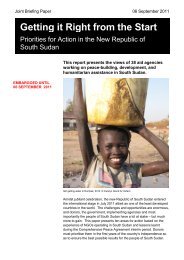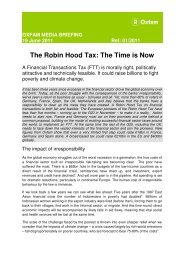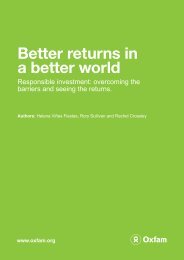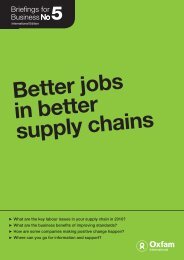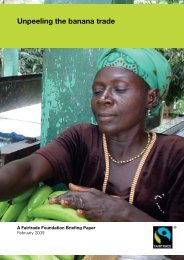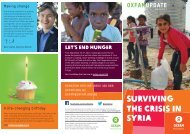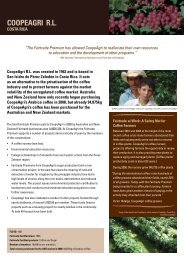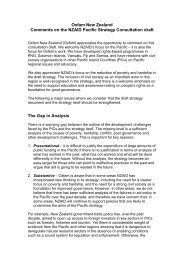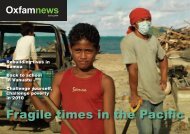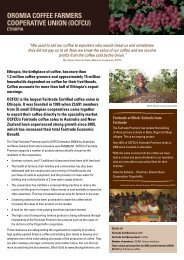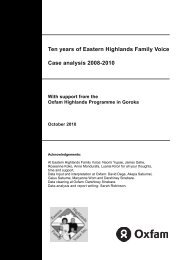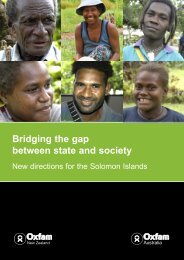Growing a Better Future - Oxfam International
Growing a Better Future - Oxfam International
Growing a Better Future - Oxfam International
- No tags were found...
You also want an ePaper? Increase the reach of your titles
YUMPU automatically turns print PDFs into web optimized ePapers that Google loves.
113 US Government Accountability Office (GAO) (2009)‘<strong>International</strong> Food Assistance: Local and Regional ProcurementCan Enhance the Efficiency of US Food Aid, but Challenges MayConstrain Its Implementation Purchase’, GAO-09-570.Washington, DC: GAO. http://www.gao.gov/new.items/d09570.pdf114 <strong>Oxfam</strong> America (2011) ‘Under Pressure: reducing disaster riskand enhancing US emergency response capacity in an era ofclimate change’.115 Based on 2009 food aid volumes. <strong>Oxfam</strong> calculation based ondata from http://www.usaid.gov/our_work/humanitarian_assistance/ffp/fy09.ifar.pdf Note: The USA has begun prepositioningits food aid at strategic points around the globe. Thishas decreased the amount of time it takes for food aid to arrive atits destination, however, it may actually increase the total cost ofdelivery due to storage costs at the strategic points and in anadditional transport step. This may lower the 15.2% figure, andtherefore the absolute number of additional beneficiaries,slightly.116 <strong>Oxfam</strong> <strong>International</strong> (2010) ‘Righting Two Wrongs: Making a NewGlobal Climate Fund Work for Poor People’, see http://www.oxfam.org/en/policy/righting-two-wrongs117 UN High Level Task Force on the Global Food Crisis,Comprehensive Framework for Action 2008, p.9.118 World Bank, World Development Indicators.119 calculated from http://www.fao.org/economic/ess/ess-data/ess-fs/ess-fadata/en/120 calculated from http://faostat.fao.org/site/550/DesktopDefault.aspx?PageID=550121 calculated from http://www.fao.org/economic/ess/ess-data/ess-fs/ess-fadata/en/122 The proportion of people undernourished in Brazil fell from 11%in 1990–2 to 6% in 2005–6 (reduction of 45%), see http://www.fao.org/docrep/013/i1683e/i1683e.pdf123 CONSEA 2009 ‘Building up the National Policy and System forFood and Nutrition Security: the Brazilian experience’124 World Bank (2008) ‘Double Jeopardy’, op. cit. See http://goo.gl/BhRWa125 IEA (2010) ‘World Energy Outlook 2010’ estimates support forbiofuels in 2009 was $20bn, the bulk of it in the USA and EU. Thisfigure is projected to rise to $45bn by 2020 and $65bn by 2035.126 There has been limited progress in this area with the creation ofthe UN Central Emergency Response Fund (CERF) in 2006, toensure that resources are available for underfunded emergencyresponses and sudden-onset crises. It is a central fund, andmost of its money is not earmarked for any specific use.However, while this has eased the problem of a lack of voluntarydonor funding for some emergencies, it merely shifts the problemto another arena, since the CERF itself depends on donorwillingness to replenish it.127 There has also been limited progress towards more cash-basedprogramming. WFP has embraced the idea but in 2010–11 onlydevoted 7 per cent of its portfolio to cash programming. (J. Prout,WFP, ‘Cash and Vouchers’, presentation to WFP 2 nd Global Cashand Vouchers Workshop, 22–3 November 2010, Rome). Donors,too, are changing, but many still devote the bulk of their fundingto food aid. For example, DG ECHO currently allocates about10% of its food assistance portfolio to cash, while 60% goes toin-kind support (the remainder goes to a mix of the two). DGECHO, ‘DG ECHO Perspectives on Cash TransferProgramming’, presentation to CaLP global learning event, 16February 2011, Bangkok.128 World Bank (2008) ‘Double Jeopardy’, op. cit.129 UN High Level Task Force on the Global Food Crisis (2008)Comprehensive Framework for Action.130 For example, on cash transfers, see http://www.dfid.gov.uk/r4d/PDF/Articles/Evidence_Paper-FINAL-CLEARAcknowledgement.pdf131 The UN Social Protection Floor (SPF) Initiative promotesuniversal access to essential social transfers and services.Calculations by various UN agencies show that a basic floor ofsocial transfers is globally affordable at virtually any stage ofeconomic development, even if the funding is not yet availableeverywhere. The SPF corresponds to a set of basic social rights,services and facilities that all people should enjoy. See http://www.ilo.org/gimi/gess/ShowTheme.do?tid=1321132 http://www.ids.ac.uk/go/idsproject/the-new-bottom-billion133 <strong>Oxfam</strong> <strong>International</strong> (2010) ‘Halving Hunger’, op. cit.134 Ibid.135 A key deliverable for the CFS is a new Global StrategicFramework on Food Security and Nutrition – a dynamicframework which can provide a set of rules to ensure cooperationand policy coherence between countries and whichcan evolve to meet the challenges arising in the age of growingcrisis.136 FAO High-Level Expert Forum (2009) ‘The Special Challenge forSub-Saharan Africa’, http://www.fao.org/fileadmin/templates/wsfs/docs/Issues_papers/HLEF2050_Africa.pdf137 The Economist, August 26 2010, ‘The Miracle of the Cerrado’,http://www.economist.com/node/16886442?story_id=16886442138 Agriculture is the most important source of employment forwomen in rural areas in most developing country regions, FAO(2011) ‘State of Food and Agriculture’.139 Growth originating in agriculture, in particular the smallholdersector, is at least twice as effective in benefiting the poorestpeople as growth from non-agricultural sectors, FAO (2010) ‘Howto Feed the World’, p.2. See also Ha-Joon Chang (2009)‘Rethinking Public Policy in Agriculture: Lessons from History,Distant and Recent’, Journal of Peasant Studies, 36:3, July 2009,pp.477-515.140 Jules Pretty et al., ‘Resource-Conserving Agriculture IncreasesYields in Developing Countries’, Environmental Science andTechnology, 40:4, 2006, pp. 1114−9. The 79% figure refers to the360 reliable yield comparisons from 198 projects. There was awide spread in results, with 25 per cent of projects reporting a100% increase or more.141 J. Pretty et al., ‘Sustainable Intensification in African Agriculture’,<strong>International</strong> Journal of Agricultural Sustainability, 9:1,forthcoming in 2011.142 Africare, <strong>Oxfam</strong> America, WWF–ICRISAT Project (2010) ‘MoreRice for People, More Water for the Planet’, WWF–ICRISATProject, Hyderabad, India.143 P. Collier and S. Dercon (2009) ‘African Agriculture in 50 Years:Smallholders in a Rapidly Changing World?’, Presentation in theFAO High-Level Expert Forum, ftp://ftp.fao.org/docrep/fao/012/ak983e/ak983e00.pdf144 Low yields do not mean low productivity. The former measuresharvest per unit area. The latter measures harvest divided acrossall factors of production: land, capital, and so on.145 ‘A Special Report on Feeding the World’, The Economist,Feburary 24, 2011.71



